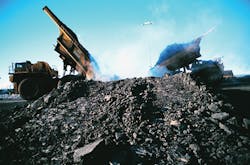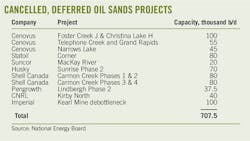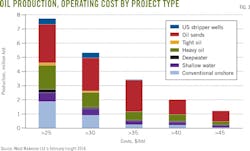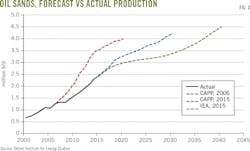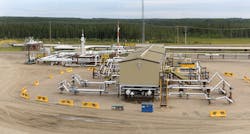Canadian oil sands output poised for growth despite oil prices
Canadian oil sands producers report projects already under construction will boost total oil sands output for about 5 years regardless of crude oil prices, although companies are trying to cut costs through layoffs or by deferring new investments. While it's unlikely any new oil sands projects will be announced until oil prices recover, production increases on existing projects have helped offset new project deferrals.
Oil sands projects' long life and high-shutdown costs incentivize operators to continue production. Steve Williams, chief executive officer of Suncor Energy Inc., affirmed during a fourth-quarter conference call that Canadian oil sands production will grow.
"There are major capital investments in flight that will be completed, and it makes absolute sense to complete those," Williams said. Oil sands account for about 80% of Suncor's production. The company anticipates its oil sands output to be 430,000-460,000 b/d during 2016 compared with 463,000 b/d in 2015 (Figs. 1-2).
In late 2017, Suncor and partners plan to start up the Fort Hills LP project, expected to produce 180,000 b/d for 50 years. Suncor is the developer and operator.
During IHS CERAWeek in Houston on Feb. 23, Williams said he anticipates Fort Hills "will be the first mega project in the oil sands to come in on cost and on schedule."
Suncor holds 50.8% interest in Fort Hills after buying a 10% stake from Total E&P Canada Ltd. last year (OGJ Online, Sept. 21, 2015). Total E&P Canada still holds 29.2% of Fort Hills, and Teck Resources Ltd. 20.0%.
Suncor is also acquiring Canadian Oil Sands through a successful share tender offer that closed in late February.
Williams said US light, sweet oil prices need to be $60-80/bbl to warrant any new investment in oil sands mines and believes these prices will return
Analysts and consultants agree with Williams that oil sands production will continue to grow for now, citing costs and logistics involved with project shut-ins and producers' need for revenue to cover debt.
"It really makes no economic sense to bring down production at this point because most of the costs are sunk," said Stewart Glickman, S&P Capital IQ Equity analyst.
Wood Mackenzie Ltd. discussed the complexities of stopping oil sands production in a February report titled "Oil prices: production shut-ins and the cost curve."
Stopping steam injection into oil sand reservoirs "would result in a long and expensive restart, thus an oil sands producer will only halt production if it is believed that the oil price will be low for a sustained period," WoodMac said.
Fuel expenses are a large oil sands expense, WoodMac said, noting that lower oil costs and lower fuel costs could mean lower operating costs.
RBC Dominion Securities analysts issued a Feb. 25 research report in which they forecast oil sands production will grow by about 760,000 b/d to 2020, down from their earlier forecast of 1 million b/d. Citing cancelled and deferred projects by Cenovus Energy Inc., Royal Dutch Shell PLC, Suncor Energy Inc. and others, RBC now expects production from northern Alberta will reach 3.1 million b/d by 2020.
Oil sands production has grown typically 10%/year, but RBC analysts said production growth likely will slow to 6%/year before levelling off.
"Once oil prices recover to levels which support the sanctioning of new projects, oil sands growth will take years to surface," RBC analyst Greg Pardy said in the report.
Cost cuts
Some oil sands producers have reduced costs at existing plants. Exxon Mobil Corp. said in securities filings that its average cost/bbl of bitumen has dropped by 41% from a year ago to $19.20/bbl, The Globe and Mail reported.1
ExxonMobil owns about 70% of Imperial Oil Ltd., which is expanding output at its massive Kearl mine..
Canadian Natural Resources Ltd. recently said it cut $9 (Can.)/bbl off its Horizon bitumen mine's costs in 2015 compared with 2014. Chief Financial Officer Corey Bieber said in January he believes more savings are possible because competition for labor and materials is diminishing.
Cenovus Energy Inc., Calgary, said workforce reductions were part of how it cut its 2016 budget to $1.2-1.3 billion (Can.), down 27% from 2015 and 59% from 2014 (OGJ Online, Dec. 10, 2015).
Despite these cost-saving measures, Cenovus said its oil sands production increased by 9% in 2015 compared with 2014. About one-quarter of Cenovus's 2015 cost savings came from deferring work.
Executives plan to adjust 2016 discretionary spending and executive cash compensation. Budget reductions include lower spending at Cenovus's Foster Creek and Christina Lake oil sands projects (Figs. 3-4).
Cenovus will cut operating expenses by prioritizing repairs and maintenance. It also will cancel or delay nonessential work, including delaying until 2017 a scheduled turnaround at Foster Creek , which ConocoPhillips co-owns.
Robert Pease, executive vice-president corporate strategy and president, told a Credit Suisse conference in Vail, Colo., Feb. 24 that Cenovus is using the oil price slump to become more efficient and plans to resume some of its deferred projects when prices rebound
Cenovus plans to continue focused investment in technology development geared toward improved well cost. Pease said the company is working to reduce drilling days, completion times, and projects' surface footprints.
The company lowered its Foster Creek 2015 operating costs to $12.60/bbl, down 23% from 2014. Non-fuel operating costs were $9.80/bbl, an 18% decline from a year earlier.
Cenovus reported "excellent results" with new reservoir management techniques to improve wellbore conformance and well productivity at Foster Creek. Enhancements include downhole instrumentation and optimization work as well as steam circulation startup on new pads. Wellbore conformation at Foster Creek has increased to 90% compared with 70-75% previously.
At Christina Lake, operating costs were $8/bbl in 2015, a 28% decline from 2014. Non-fuel operating costs were $5.81/bbl, 22% lower than 2014.
Foster Creek Phase G and Christina Lake Phase F expansions are on track, with oil anticipated third-quarter 2016. A Chrisina Lake optimization was recently completed.
Cenovus expects the expansions and optimization to add 100,000 b/d to production (50,000 b/d net), an increase of about 35% from its current oil sands production. Cenovus reports 21% production compound annual growth since 2007, Pease said.
Pease said the Alberta Energy Regulator in December 2015 approved Christina Lake Phase H, a potential future expansion that would add 50,000 b/d of incremental gross capacity.
Pengrowth Energy Corp., Calgary, continues expanding its commercial steam operations at its Lindbergh thermal project in the Cold Lake area of eastern Alberta. By Dec. 31, 2018, with two expansion phases, Pengrowth expects Lindbergh production to reach 40,000-50,000 b/d, and commerical steam operations started there in December 2014.
Most deferred projects announced so far have not involved projects already under construction, but Royal Dutch Shell PLC halted construction of its 80,000-b/d Carmon Creek thermal in situ project in October 2015.
Shell took about $2 billion in third-quarter charges as a result, and wrote off estimated proved reserves of 418 million bbl of bitumen as of yearend 2014. Shell kept Carmon Creek leases and some equipment while studying options for the project, 100% owned by Shell and sanctioned in 2013 (OGJ Online, Oct. 31, 2013).
Layoffs also are occurring. Suncor announced plans to eliminate 1,000 contract and employee positions across its operations, including refining and gasoline retailing.
NEB report
The National Energy Board (NEB) has forecast Canadian crude oil production of 6.1 million b/d by 2040 of which oil sands are expected to account for 4.8 million b/d.2 NEB plans to update its Canada's Energy Future 2016 report in November and adjust some of its forecasting methods.
"In situ bitumen production is by far the dominant source of overall production by 2040 as operators continue to favor steam-assisted gravity drainage (SAGD) over other extraction methods," NEB said.
Oil sands production estimates for the first 5 years of NEB's forecast to 2040 took into account projects already producing or currently under construction. The long-term production forecast involved historical production growth rates, projected economic returns, and capital expenditure requirements.
"The industry continues to develop in situ projects and focuses less on mining and upgrading projects," NEB said. "The economics of mining and upgrading operations are relatively less attractive compared to in situ over the projection period."
In situ operations accounted for most oil sands production in 2014, and this trend is expected to continue, NEB said. By 2040, in situ is expected to account for 3.1 million b/d, or 66% of total bitumen production.
"The effect of recent low crude oil prices on oil sands production is limited in the near-term projections," NEB said. "Oil sands producers are unlikely to lower production from currently producing projects or delay projects that are nearly complete."
Production growth in the next 5 years is expected to keep pace with recent years but then slow after 2020 because of operators' decisions to defer or cancel projects, NEB said (see accompanying table).
Historically, mined bitumen production and bitumen upgrading, where the bitumen is converted into a higher quality crude oil, have been closely related because mines were directly associated with upgraders.
However, the startup of two mining projects without associated upgraders, Kearl in 2014 and Fort Hills, scheduled for 2017, demonstrates that a direct relationship no longer applies, NEB said. Mined bitumen production outpaces upgrading over the course of the projection.
After 2020, growth rates for oil sands production are expected to decline, partly because higher overall production levels will result in more maintenance spending and leave a relatively smaller amount of capital available for new projects.
"As is often the case with any source of supply, new oil sands projects will likely experience a decline in the overall quality of the reservoir as core production areas are exploited, leading to a drop in productivity," NEB said. "Also, several projects will be terminated at the end of their productive life throughout the projection period."
Emissions reductions
Canada's oil sands could prove crucial to meeting future crude demand, but only if producers can drive down costs while slashing greenhouse-gas emissions, Fatih Birol, executive director of the International Energy Agency told IHS CERAWeek in Houston.
Following CERAWeek, Birol went to Ottawa and met with Natural Resources Minister Jim Carr.
"My plea to the oil sands industry is to increase the productivity and reduce the carbon footprint by having access to cleaner technologies for production processes," Birol said.
He believes long-term growth in oil sands production can be consistent with Canada's efforts to meet its climate-change commitments to reduce greenhouse-gas emissions by 30% below 2005 levels by 2030. But he emphasized that this hinges on the industry reducing its emissions.
"It is extremely crucial that they make more use of advance technologies," he said of oil sands producers. "This may well increase the cost of production a bit, but it is a key asset-protection strategy for them." Oil sands producers will otherwise continue facing opposition to needed infrastructure and also come under political pressure in key markets, Birol said.
IEA expects prices will begin rising significantly in 2017, when declines in non-OPEC production and growing global demand bring the market back into balance. It predicts prices will rebound to $80/bbl by 2020.
Birol said most oil sands projects would be profitable at $80/bbl. During 2015-20, IEA suggests oil sands production will grow by 800,000 b/d, and then pause after 2020 while producers regain confidence to make new investments.
Canada's Oil sands Innovation Alliance (COSIA) is researching ways to reduce freshwater use and increase water-recycling rates on oil sands mining and in situ operations.
COSIA has spent more than $950 million to develop 777 environmental technologies, the group said. COSIA members involved with in situ operations announced in late 2014 a goal to cut freshwater use in half by 2022, members using 0.2 bbl of fresh water/bbl of bitumen vs. the current 0.4 bbl of fresh water.
COSIA members have also announced a goal to collectively reduce net water use intensity from the Athabasca River and its tributaries by 30% by 2022.
Plans to achieve this include:
• Optimizing water reduction and recycling opportunities.
• Reducing the amount of water retained in tailings and confirming the technical basis for returning treated water to the Athabasca River
• Understanding and managing the cumulative effects on the Athabasca River watershed.
References
1. McCarthy, Shawn and Lewis, Jeff, "Canadian oil sands are crucial if producers cut costs, emissions: IEA," Globe and Mail, Feb. 25, 2016.
2. National Energy Board, "Canada's Energy Future 2016: Energy Supply and Demand Projections to 2040," January 2016.

Paula Dittrick | Senior Staff Writer
Paula Dittrick has covered oil and gas from Houston for more than 20 years. Starting in May 2007, she developed a health, safety, and environment beat for Oil & Gas Journal. Dittrick is familiar with the industry’s financial aspects. She also monitors issues associated with carbon sequestration and renewable energy.
Dittrick joined OGJ in February 2001. Previously, she worked for Dow Jones and United Press International. She began writing about oil and gas as UPI’s West Texas bureau chief during the 1980s. She earned a Bachelor’s of Science degree in journalism from the University of Nebraska in 1974.
